Strain Response Analysis and Experimental Study of the Cross-Fault Buried Pipelines
Abstract
1. Introduction
2. Equivalent-Spring Boundary-Based Finite Element Model of the Fault Crossing
2.1. Key Assumptions in the Finite Element Modeling
- (1)
- Fault movement is modeled as the relative displacement between the hanging wall and footwall along the fault plane, neglecting the influence of the fault fracture zone.
- (2)
- In the pipeline’s small deformation zones, it is assumed that no lateral displacement occurs between the pipeline and surrounding soil, with only minor axial strains present.
- (3)
- This study focuses specifically on the strain response of fault-crossing pipelines, excluding other factors such as seismic wave propagation and soil liquefaction.
- (4)
- The analyzed pipeline is assumed to be in optimal condition without initial defects, operating normally within its design lifespan.
2.2. Establishment of the Finite Element Model
2.2.1. Equivalent-Spring Boundary Theory
2.2.2. Geometric Modeling and Meshing
2.2.3. Nonlinear Contact and Boundary Conditions
3. Model Experiment Design for Fault Crossings
3.1. Model Experiment Design Theory
3.2. Experimental Platform Design
3.3. Design of Model Experiment Conditions
4. Model Experimental System Installation
4.1. FEA of the Experimental Conditions
4.2. Sensor Selection and Deployment
4.3. Experiment System Installation
4.4. Soil Loading
5. Fault-Crossing Experiment Evaluation
5.1. Analysis of Model Experimental Results
5.2. Analysis of Results for Prototype-Scale Conditions Analysis and Comparison of Prototype-Scale FEA Results with Experimental Results
6. Conclusions
Author Contributions
Funding
Data Availability Statement
Conflicts of Interest
References
- O’Rourke, T.D.; Mccaffrey, M.A. Buried pipeline response to permanent earthquake ground movements. In Proceedings of the Eighth World Conference on Earthquake Engineering, San Francisco, CA, USA, 21–28 July 1984; Prentice-Hall, Inc.: Upper Saddle River, NJ, USA, 1984; Volume 7. [Google Scholar]
- Chen, W.W.; Shih, B.J.; Chen, Y.C.; Hung, J.H.; Hwang, H.H. Seismic response of natural gas and water pipelines in the ji-ji earthquake. Soil Dyn. Earthq. Eng. 2002, 22, 1209–1214. [Google Scholar] [CrossRef]
- Wang, X.; Guo, E.; Zhang, M. Analysis of and solutions to seismic damages of gas pipeline networks in the Wenchuan earthquake. World Earthq. Eng. 2012, 28, 44–50. [Google Scholar]
- Vigny, C.; Socquet, A. The 2010 Mw 8.8 Maule megathrust earthquake of central Chile, monitored by GPS. Science 2011, 332, 1417–1421. [Google Scholar] [CrossRef]
- Chiou, Y.J.; Chi, S.Y.; Chang, H.Y. A study on buried pipeline response to fault movement. J. Press. Vessel. Technol.-Trans. Asme 1994, 116, 36–41. [Google Scholar] [CrossRef]
- Newmark, N.M.; Hall, W.J. Pipeline design to resist large fault displacement. In Proceedings of the US National Conference on Earthquake Engineering, Ann Arbor, MI, USA, 18–20 June 1975; pp. 416–425. [Google Scholar]
- Kennedy, R.P.; Williamson, R.A.; Chow, A.M. Fault movement effects on buried oil pipeline. J. Transp. Eng. 1977, 103, 617–633. [Google Scholar]
- Wang, L.R.L.; Yeh, Y.H. A refined seismic analysis and design of buried pipeline for fault movement. Earthq. Eng. Struct. Dyn. 1985, 13, 75–96. [Google Scholar] [CrossRef]
- Wang, L.R.L.; Wang, L.J. Parametric study of buried pipelines due to large fault movements. In Proceedings of Third China-Japan-US Trilateral Symposium on Lifeline Earthquake Engineering; Kobe Univ. of Japan: Kobe, Japan, 1995; pp. 165–172. [Google Scholar]
- Karamitros, D.K.; Bouckovalas, G.D.; Kouretzis, G.P. Stress analysis of buried steel pipelines at strike-slip fault crossings. Soil Dyn. Earthq. Eng. 2007, 27, 200–211. [Google Scholar] [CrossRef]
- Trifonov, O.V.; Cherniy, V.P. A semi-analytical approach to a nonlinear stress strain analysis of buried steel pipelines crossing active faults. Soil Dyn. Earthq. Eng. 2010, 30, 1298–1308. [Google Scholar] [CrossRef]
- Trifonov, O.V.; Cherniy, V.P. Elastoplastic stress-strain analysis of buried steel pipelines subjected to fault displacements with account for service loads. Soil Dyn. Earthq. Eng. 2012, 33, 54–62. [Google Scholar] [CrossRef]
- Guo, E.; Feng, Q. A seismic analysis method for buried steel pipes crossing faults. Earthq. Eng. Eng. Vib. 1999, 19, 43–47. [Google Scholar]
- Takada, S.; Hassani, N.; Fukuda, K. A new proposal for simplified design of buried steel pipes crossing active faults. Earthq. Eng. Struct. Dyn. 2001, 30, 1243–1257. [Google Scholar] [CrossRef]
- Liu, A.W.; Hu, Y.X.; Zhao, F.X.; Li, X.J.; Takada, S.; Zhao, L. An equivalent-boundary method for the shell analysis of buried pipelines under fault movement. Acta Seismol. Sin. 2004, 26 (Suppl. S1), 141–147. [Google Scholar] [CrossRef]
- Yan, X.; Zhang, L.; Yang, X. Strain response study of oil-gas pipelines crossing earthquake faults based on the pipe-soil coupling and the large deformation shell model. China Civ. Eng. J. 2010, 43, 132–139. [Google Scholar]
- Joshi, S.; Prashant, A.; Deb, A.; Jain, S.K. Analysis of buried pipelines subjected to reverse fault motion. Soil Dyn. Earthq. Eng. 2011, 31, 930–940. [Google Scholar] [CrossRef]
- Fadaee, M.; Farzaneganpour, F.; Anastasopoulos, I. Response of buried pipeline subjected to reverse faulting. Soil Dyn. Earthq. Eng. 2020, 132, 1–9. [Google Scholar] [CrossRef]
- Vazouras, P.; Karamanos, S.A.; Dakoulas, P. Mechanical behavior of buried steel pipes crossing active strike-slip faults. Soil Dyn. Earthq. Eng. 2012, 41, 164–180. [Google Scholar] [CrossRef]
- Li, L.; Qiao, L.; Fan, J.; Zhang, Y. Mechanical behavior of polyethylene pipes under strike-slip fault movements. Polymers 2022, 14, 987. [Google Scholar] [CrossRef]
- Zhang, R.; Wang, C.; Li, S.; Zhang, J.; Liu, W. Numerical simulation study on the performance of buried pipelines under the action of faults. Appl. Sci. 2023, 13, 11266. [Google Scholar] [CrossRef]
- Huang, D.-L.; Cen, H.; Wang, H.-Y.; Liu, Q.; Zong, Z.-L.; Tang, A.-P. Tang. Study on response patterns and influencing factors of buried pipelines with corrosion defects under fault action. Appl. Eng. Sci. 2024, 18, 100176. [Google Scholar] [CrossRef]
- Makrakis, N.; Psarropoulos, P.N.; Sextos, A.; Tsompanakis, Y. Do Soft Soil Layers Reduce the Seismic Kinematic Distress of Onshore High-Pressure Gas Pipelines? Bull. Earthq. Eng. 2024, 22, 159–189. [Google Scholar] [CrossRef]
- Zhang, W.; Ayello, F.; Honegger, D.; Taciroglu, E.; Bozorgnia, Y. Comprehensive numerical analyses of the seismic performance of natural gas pipelines crossing earthquake faults. Earthq. Spectra 2022, 38, 1661–1682. [Google Scholar] [CrossRef]
- Gu, X.-T.; Zang, X.-R.; Zhang, Z.-Y.; Yang, P.; Miao, W.-Z.; Cao, P.; Zhao, B. Reliability analysis of large-diameter high-grade-steel natural gas pipelines under fault action. Pet. Sci. 2022, 19, 2387–2398. [Google Scholar] [CrossRef]
- Tan, N.; Zhou, L.; Zheng, W.; Song, H.; Sun, Z.; Wang, Z.; Wang, G.; Wang, G.; Zhang, L.; Zhou, X. Using finite element method for stress-strain evaluation of commonly used buried pipelines in fault. Energies 2022, 15, 1655. [Google Scholar] [CrossRef]
- Takada, S. Experimental study on the mechanical properties of PVC pipes during soil subsidence. In Earthquake Resistance of Underground Pipelines; Hong, Z.L., Ed.; Academic Book Press: Beijing, China, 1987; pp. 204–214. [Google Scholar]
- Sim, W.W.; Towhata, I.; Yamada, S.; Moinet, G.J.M. Shaking table tests modelling small diameter pipes crossing a vertical fault. Soil Dyn. Earthq. Eng. 2012, 35, 59–71. [Google Scholar] [CrossRef]
- Zhang, Z.; Wang, J.; Xu, Y. Shaking table test for cross-fault buried pipelines (I)—Model design. China Civ. Eng. J. 2011, 44, 93–98. [Google Scholar]
- Deng, L.S.; Zhang, W.Z.; Dai, Y.; Fan, W.; Li, Y.B.; Ren, S.; Li, P. Seismic response of a water transmission pipeline across a fault zone adopting a large-scale vibration table test. Front. Earth Sci. 2021, 9, 777551. [Google Scholar] [CrossRef]
- Liu, W.; Huang, C.J.; Zhang, S.F.; Song, Z.Y. Centrifuge tests of large-diameter steel pipes crossing strike-slip faults. Eng. Struct. 2023, 279, 115124. [Google Scholar] [CrossRef]
- Liu, W.; Huang, C.J.; Zhang, S.F.; Miao, H.Q. Centrifuge test of large-diameter segmented ductile iron pipes crossing strike-slip faults. Structures 2023, 57, 105218. [Google Scholar] [CrossRef]
- Rojhani, M.; Moradi, M.; Galandarzadeh, A.; Takada, S. Centrifuge modeling of buried continuous pipelines subjected to reverse faulting. Can. Geotech. J. 2012, 49, 659–670. [Google Scholar] [CrossRef]
- Choo, Y.W.; Abdoun, T.H.; O’Rourke, M.J.; Ha, D. Remediation for buried pipeline systems under permanent ground deformation. Soil Dyn. Earthq. Eng. 2007, 27, 1043–1055. [Google Scholar] [CrossRef]
- Ha, D.; Abdoun, T.H.; O’Rourke, M.J.; Symans, M.D.; O’Rourke, T.D.; Palmer, M.C.; Stewart, H.E. Centrifuge modeling of earthquake effects on buried high-density polyethylene (hdpe) pipelines crossing fault zones. J. Geotech. Geoenviron. Eng. 2008, 134, 1501–1515. [Google Scholar] [CrossRef]
- Rofooei, F.R.; Jalali, H.H.; Attari, N.K.A.; Alavi, M. Full-scale laboratory testing of buried pipelines subjected to permanent ground displacement caused by reverse faulting. In Proceedings of the 15th World Conference on Earthquake Engineering, Lisbon, Portugal, 24–28 September 2012. [Google Scholar]
- Kim, J.; Nadukuru, S.S.; Pour-Ghaz, M.; Lynch, J.P.; Michalowski, R.L.; Bradshaw, A.S.; Green, R.A.; Weiss, W.J. Assessment of the behavior of buried concrete pipelines subjected to ground rupture: Experimental study. J. Pipeline Syst. Eng. Pract. 2012, 3, 8–16. [Google Scholar] [CrossRef]
- Rofooei, F.R.; Jalali, H.H.; Attari, N.K.A.; Kenarangi, H.; Samadian, M. Parametric study of buried steel and high density polyethylene gas pipelines due to oblique-reverse faulting. Can. J. Civ. Eng. 2015, 42, 178–189. [Google Scholar] [CrossRef]
- Zhang, L. Numerical Simulations of Full Scale Tests Investigating Effect of Fault Movement on Buried Pipeline. Ph.D. Thesis, Delft University of Technology, Delft, The Netherlands, 2015. [Google Scholar]
- Demofonti, G.; Ferino, J.; Karamanos, S.; Vazouras, P.; Dakoulas, P. An integrated experimental—Numerical approach to predict strain demand for buried steel pipelines in geo-hazardous areas. In Proceedings of the Rio Pipeline Conference and Exposition, Rio de Janeiro, Brazil, 24–26 September 2013. [Google Scholar]
- Ministry of Housing and Urban-Rural Development of the People’s Republic of China. Seismic Technical Code for Oil and Gas Transmission Pipeline Engineering; Beijing China Planning Publishing House: Beijing China, 2017; pp. 22–23. [Google Scholar]
- Li, Y.; Yu, J.X.; Yu, Y. Research on local buckling and strain response prediction of submarine pipelines across strike—slip faults. World Earthq. Eng. 2019, 35, 105–131. [Google Scholar]
- Luo, X.; Cheng, S.; Zhang, Z.; Tang, K. Study of similarity theory of geomechanical model experiment in an electromagnetic field. Rock Soil Mech. 2011, 32, 1035–1039. [Google Scholar]
- Jiang, H.; Li, R.; Yan, R. Impact of geometric scale similarity levels on tunnel model experiment and its deductive computational difference. Rock Soil Mech. 2015, 36 (Suppl. S1), 270–276. [Google Scholar]
- Xiong, T.F.; Shao, S.; Wang, T.M.; Gao, Z.H. Research on physical model experiment of Xi’an metro tunnels orthogonally crossing ground fissures. Rock Soil Mech. 2010, 31, 179–186. [Google Scholar]
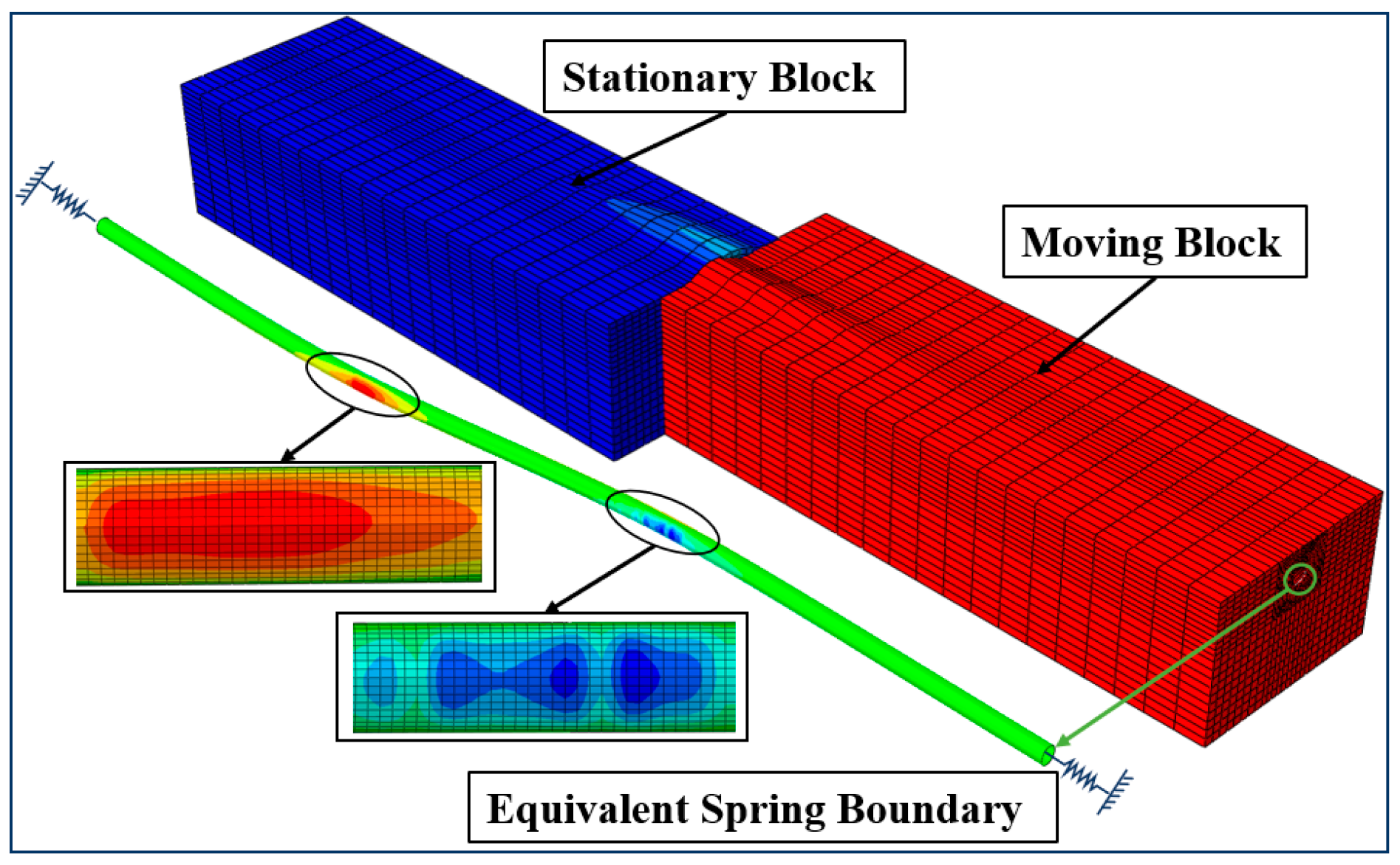
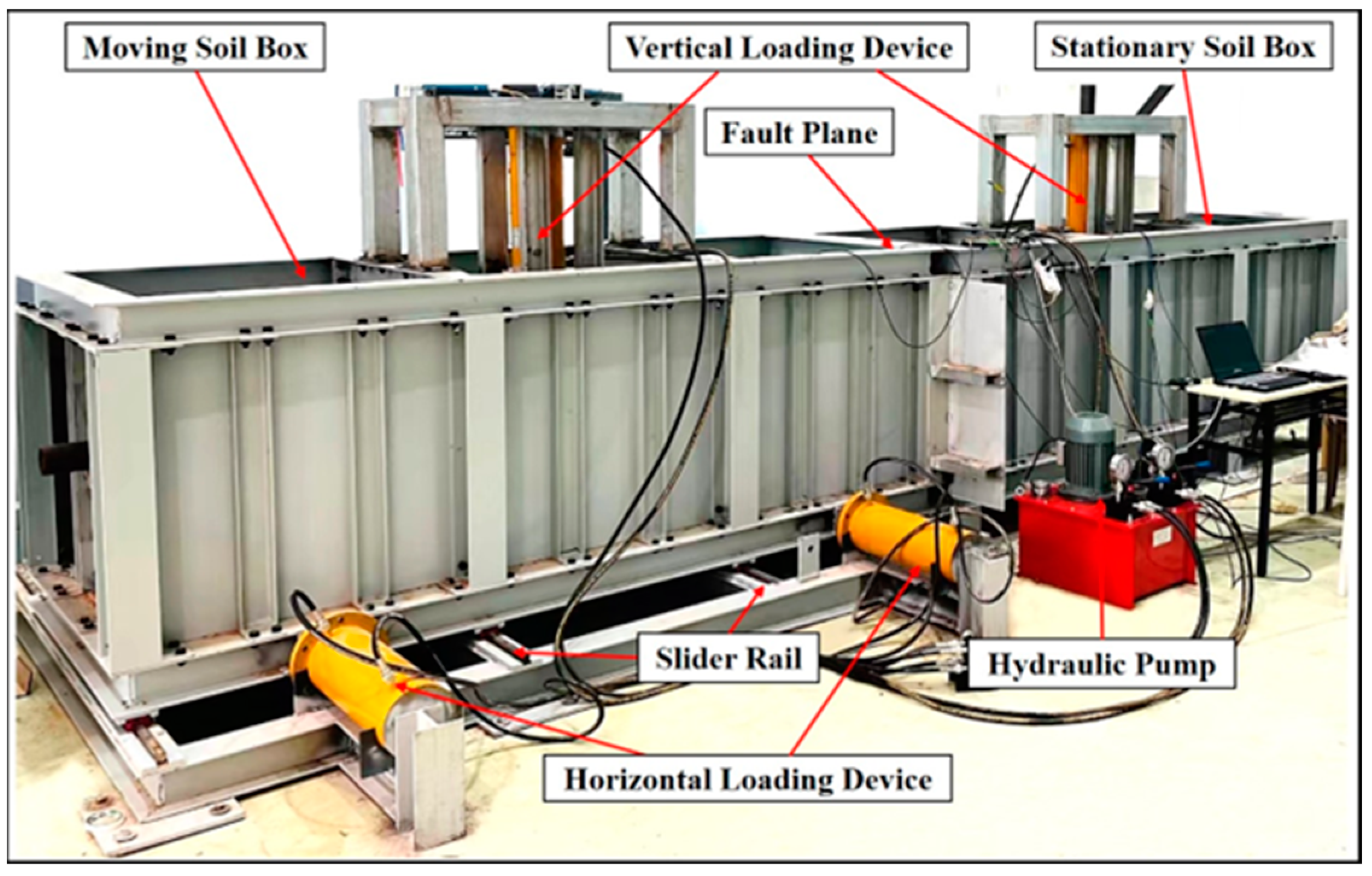


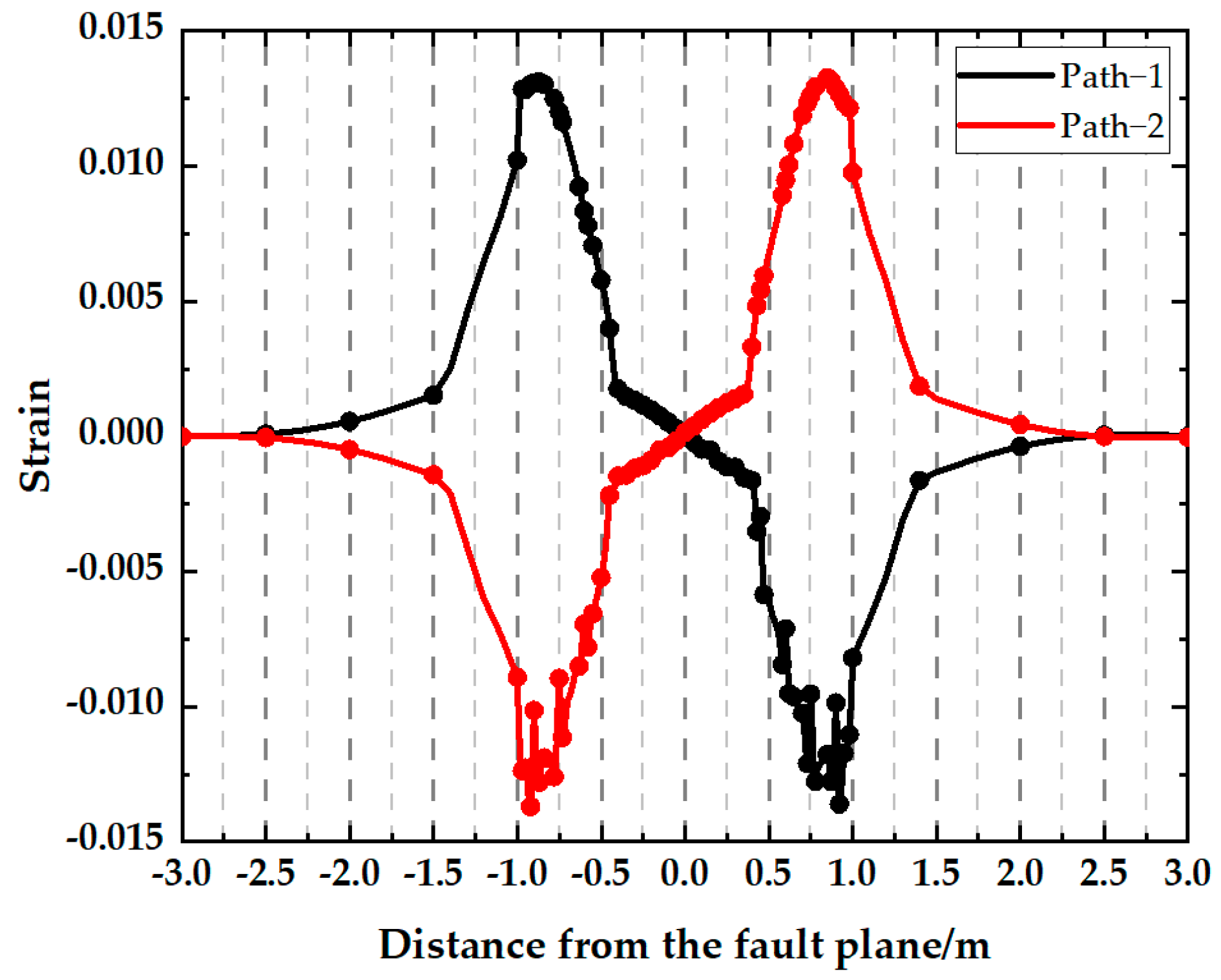

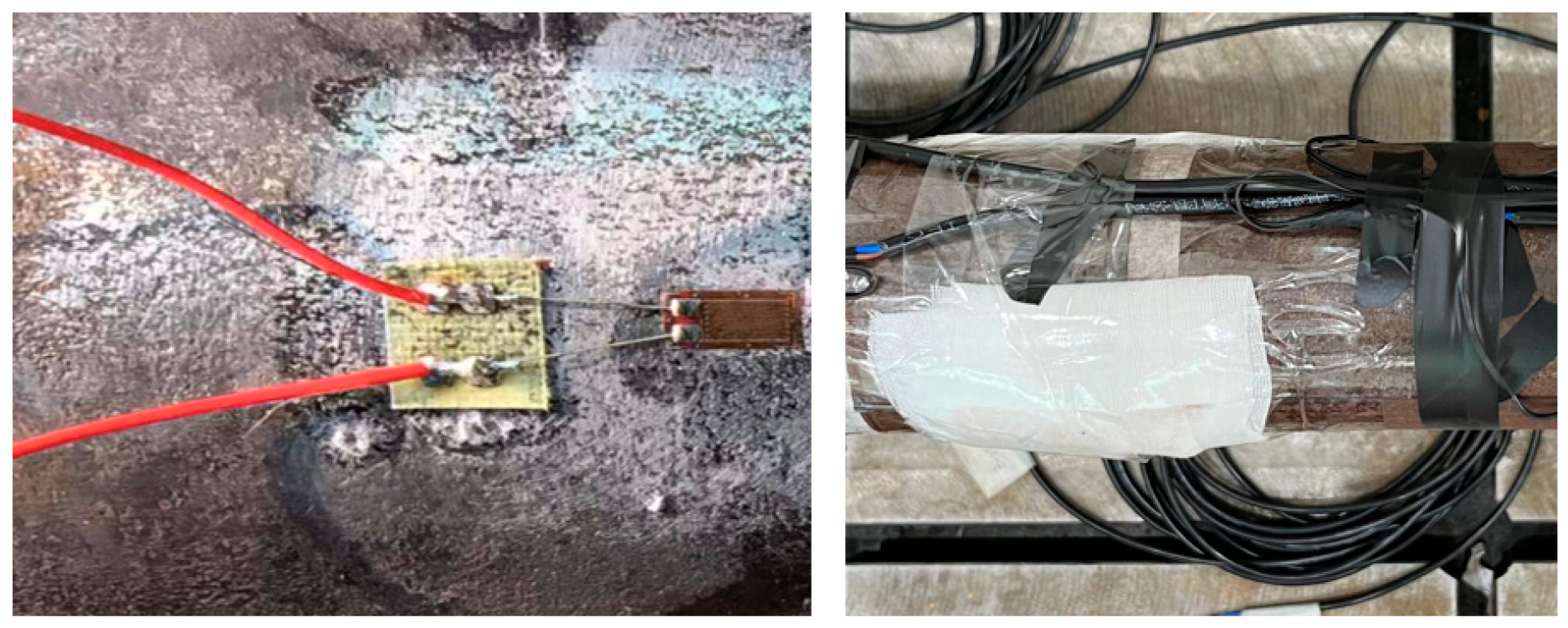
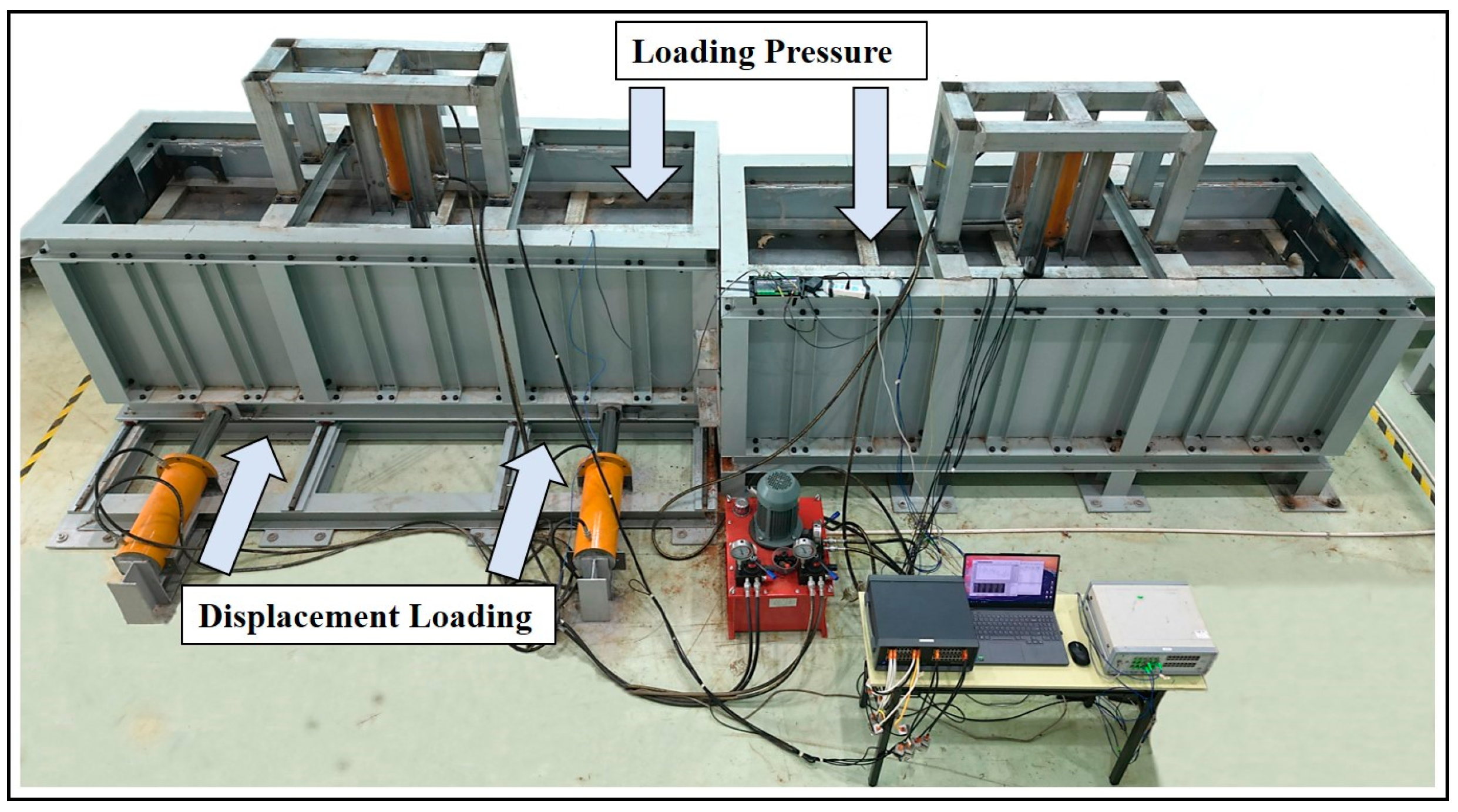


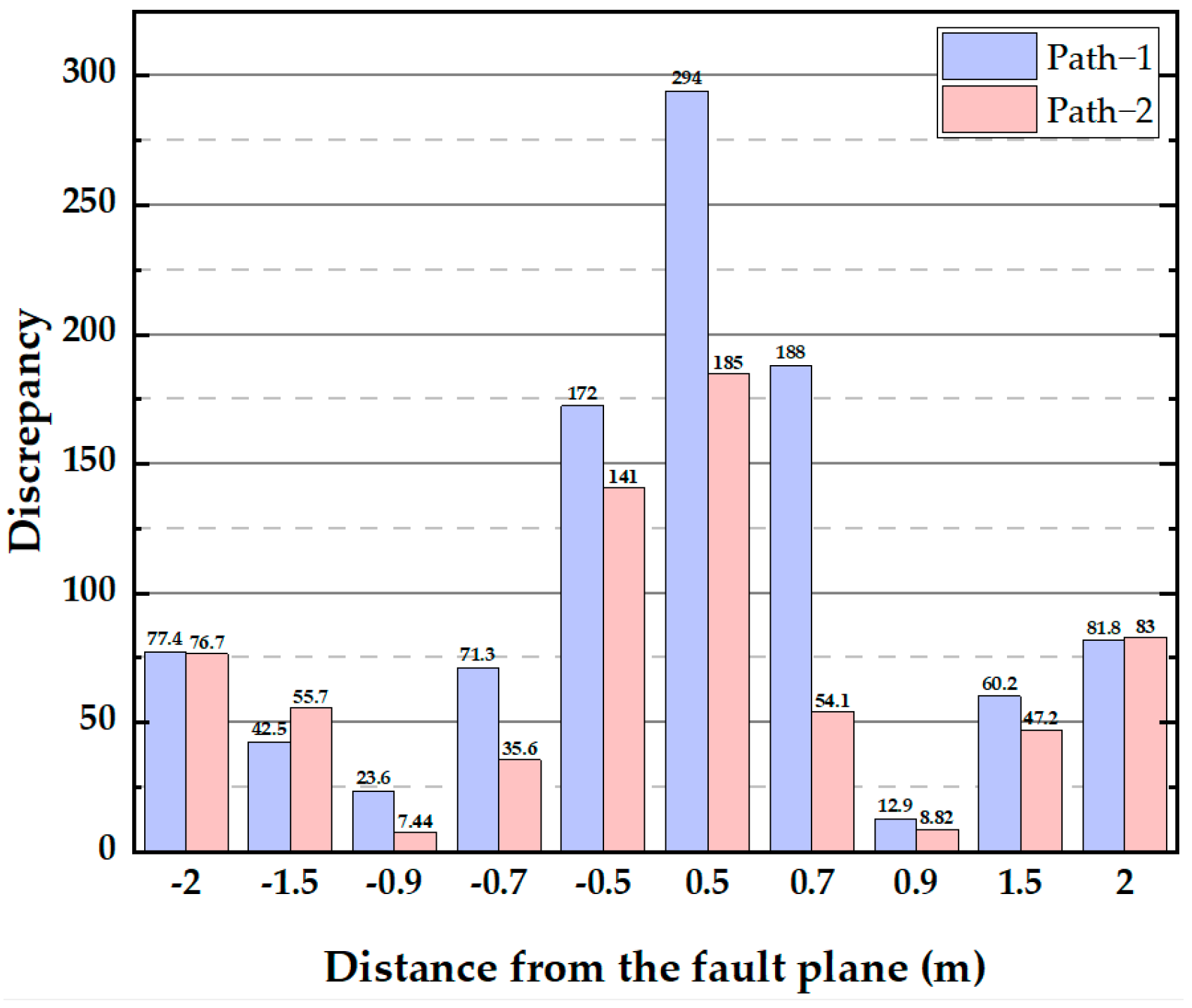

| Physical Quantity | Relations | Similarity Constant |
|---|---|---|
| ε | Cε | 1 |
| l | Cl | n |
| ρ | Cρ | 1 |
| E | CE | 1 |
| μ | Cμ | 1 |
| γ | Cγ = CρCg | 1/n |
| σ | Cσ = CρCgCl | 1 |
| δ | Cδ | n |
| H | CH | n |
| Physical Quantity | D/mm | t/mm | H/m | δ/m | σ/MPa |
|---|---|---|---|---|---|
| Prototype-scale conditions | 1219 | 54.8 | 2 | 5.48 | 0 |
| Experimental conditions | 89 | 4 | 0.15 | 0.4 | 0.04 |
| D/mm | t/mm | E/MPa | v | ρ/kg × m−³ |
|---|---|---|---|---|
| 89 | 4 | 210,000 | 0.3 | 7850 |
| E/MPa | v | ρ/kg × m−³ | ϕ/° | c/kPa |
|---|---|---|---|---|
| 6.0 | 0.4 | 2230 | 7.36 | 54.42 |
| Physical Quantity | εt | εc | lεt/m | lεc/m |
|---|---|---|---|---|
| Model finite element | 0.0133 | 0.0137 | 0.84 | 0.92 |
| Model experiment | 0.0141 | 0.0133 | 0.9 | 0.9 |
| Inversion | 0.0141 | 0.0133 | 12.33 | 12.33 |
| Finite element analysis | 0.0116 | 0.0113 | 11.33 | 11.67 |
| D-value | 17.73% | 15.04% | 8.11% | 5.35% |
Disclaimer/Publisher’s Note: The statements, opinions and data contained in all publications are solely those of the individual author(s) and contributor(s) and not of MDPI and/or the editor(s). MDPI and/or the editor(s) disclaim responsibility for any injury to people or property resulting from any ideas, methods, instructions or products referred to in the content. |
© 2025 by the authors. Licensee MDPI, Basel, Switzerland. This article is an open access article distributed under the terms and conditions of the Creative Commons Attribution (CC BY) license (https://creativecommons.org/licenses/by/4.0/).
Share and Cite
Li, Y.; Chen, S.; Hou, Y.; Xiao, W.; Fan, L.; Cai, Z.; Wu, J.; Li, Y. Strain Response Analysis and Experimental Study of the Cross-Fault Buried Pipelines. Symmetry 2025, 17, 501. https://doi.org/10.3390/sym17040501
Li Y, Chen S, Hou Y, Xiao W, Fan L, Cai Z, Wu J, Li Y. Strain Response Analysis and Experimental Study of the Cross-Fault Buried Pipelines. Symmetry. 2025; 17(4):501. https://doi.org/10.3390/sym17040501
Chicago/Turabian StyleLi, Yuan, Shaofeng Chen, Yu Hou, Wangqiang Xiao, Ling Fan, Zhiqin Cai, Jiayong Wu, and Yanbin Li. 2025. "Strain Response Analysis and Experimental Study of the Cross-Fault Buried Pipelines" Symmetry 17, no. 4: 501. https://doi.org/10.3390/sym17040501
APA StyleLi, Y., Chen, S., Hou, Y., Xiao, W., Fan, L., Cai, Z., Wu, J., & Li, Y. (2025). Strain Response Analysis and Experimental Study of the Cross-Fault Buried Pipelines. Symmetry, 17(4), 501. https://doi.org/10.3390/sym17040501




